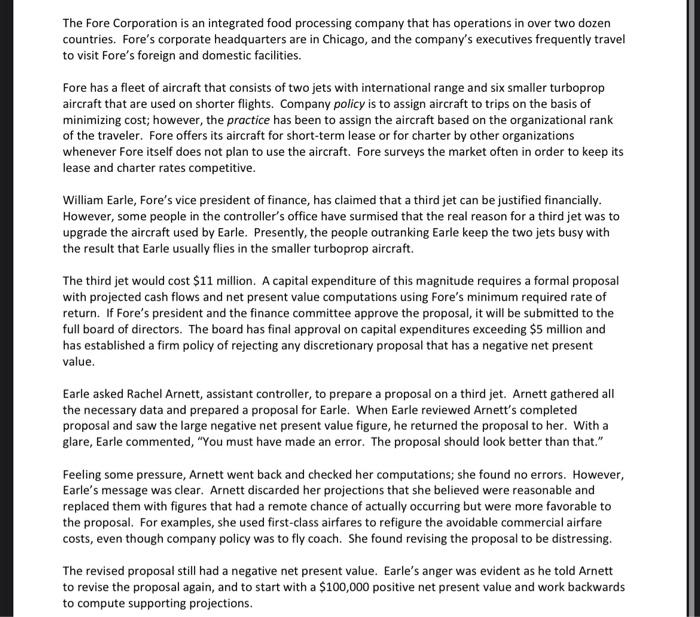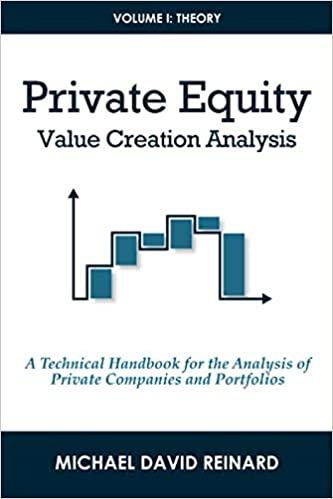1. Which, if any, of the IMA's Principles or Standards did Rachel Arnett violate? State which ones and explain why. 2. Which, if any, of the IMA's Principles or Standards did William Earle violate? State which ones and explain why. 3. After the reviewing the IMA's Statement regarding resolving ethical issues, is there anything Rachel could or should have done differently? What would your response to William have been? Be aware that there may not be a right or wrong answer to this one. The Fore Corporation is an integrated food processing company that has operations in over two dozen countries. Fore's corporate headquarters are in Chicago, and the company's executives frequently travel to visit Fore's foreign and domestic facilities. Fore has a fleet of aircraft that consists of two jets with international range and six smaller turboprop aircraft that are used on shorter flights. Company policy is to assign aircraft to trips on the basis of minimizing cost; however, the practice has been to assign the aircraft based on the organizational rank of the traveler. Fore offers its aircraft for short-term lease or for charter by other organizations whenever Fore itself does not plan to use the aircraft. Fore surveys the market often in order to keep its lease and charter rates competitive. William Earle, Fore's vice president of finance, has claimed that a third jet can be justified financially. However, some people in the controller's office have surmised that the real reason for a third jet was to upgrade the aircraft used by Earle. Presently, the people outranking Earle keep the two jets busy with the result that Earle usually flies in the smaller turboprop aircraft. The third jet would cost $11 million. A capital expenditure of this magnitude requires a formal proposal with projected cash flows and net present value computations using Fore's minimum required rate of return. If Fore's president and the finance committee approve the proposal, it will be submitted to the full board of directors. The board has final approval on capital expenditures exceeding $5 million and has established a firm policy of rejecting any discretionary proposal that has a negative net present value. Earle asked Rachel Arnett, assistant controller, to prepare a proposal on a third jet. Arnett gathered all the necessary data and prepared a proposal for Earle. When Earle reviewed Arnett's completed proposal and saw the large negative net present value figure, he returned the proposal to her. With a glare, Earle commented, "You must have made an error. The proposal should look better than that." Feeling some pressure, Arnett went back and checked her computations; she found no errors. However, Earle's message was clear. Arnett discarded her projections that she believed were reasonable and replaced them with figures that had a remote chance of actually occurring but were more favorable to the proposal. For examples, she used first-class airfares to refigure the avoidable commercial airfare costs, even though company policy was to fly coach. She found revising the proposal to be distressing. The revised proposal still had a negative net present value. Earle's anger was evident as he told Arnett to revise the proposal again, and to start with a $100,000 positive net present value and work backwards to compute supporting projections. 1. Which, if any, of the IMA's Principles or Standards did Rachel Arnett violate? State which ones and explain why. 2. Which, if any, of the IMA's Principles or Standards did William Earle violate? State which ones and explain why. 3. After the reviewing the IMA's Statement regarding resolving ethical issues, is there anything Rachel could or should have done differently? What would your response to William have been? Be aware that there may not be a right or wrong answer to this one. The Fore Corporation is an integrated food processing company that has operations in over two dozen countries. Fore's corporate headquarters are in Chicago, and the company's executives frequently travel to visit Fore's foreign and domestic facilities. Fore has a fleet of aircraft that consists of two jets with international range and six smaller turboprop aircraft that are used on shorter flights. Company policy is to assign aircraft to trips on the basis of minimizing cost; however, the practice has been to assign the aircraft based on the organizational rank of the traveler. Fore offers its aircraft for short-term lease or for charter by other organizations whenever Fore itself does not plan to use the aircraft. Fore surveys the market often in order to keep its lease and charter rates competitive. William Earle, Fore's vice president of finance, has claimed that a third jet can be justified financially. However, some people in the controller's office have surmised that the real reason for a third jet was to upgrade the aircraft used by Earle. Presently, the people outranking Earle keep the two jets busy with the result that Earle usually flies in the smaller turboprop aircraft. The third jet would cost $11 million. A capital expenditure of this magnitude requires a formal proposal with projected cash flows and net present value computations using Fore's minimum required rate of return. If Fore's president and the finance committee approve the proposal, it will be submitted to the full board of directors. The board has final approval on capital expenditures exceeding $5 million and has established a firm policy of rejecting any discretionary proposal that has a negative net present value. Earle asked Rachel Arnett, assistant controller, to prepare a proposal on a third jet. Arnett gathered all the necessary data and prepared a proposal for Earle. When Earle reviewed Arnett's completed proposal and saw the large negative net present value figure, he returned the proposal to her. With a glare, Earle commented, "You must have made an error. The proposal should look better than that." Feeling some pressure, Arnett went back and checked her computations; she found no errors. However, Earle's message was clear. Arnett discarded her projections that she believed were reasonable and replaced them with figures that had a remote chance of actually occurring but were more favorable to the proposal. For examples, she used first-class airfares to refigure the avoidable commercial airfare costs, even though company policy was to fly coach. She found revising the proposal to be distressing. The revised proposal still had a negative net present value. Earle's anger was evident as he told Arnett to revise the proposal again, and to start with a $100,000 positive net present value and work backwards to compute supporting projections








